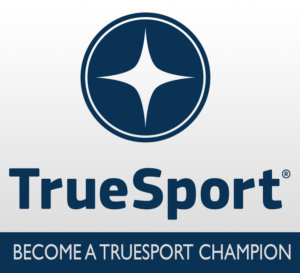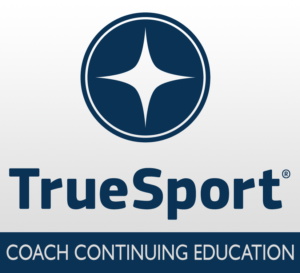Athletic Trainers: How to Use the Latest Data to Support Flexibility and Stretching
USA Cheer has partnered with TrueSport, to provide new educational tools to equip coaches, parents and young athletes with the resources to build life skills and core values for success in sports and in life. TrueSport, a movement by the U.S. Anti-Doping Agency, inspires athletes, coaches, parents, and administrators to change the culture of youth sport through active engagement and thoughtful curriculum based on cornerstone lessons of sportsmanship, character-building, and clean and healthy performance, while also creating leaders across communities through sport.
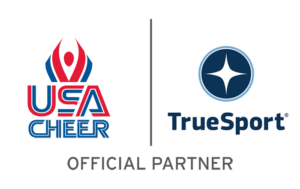
Athletic Trainers: How to Use the Latest Data to Support Flexibility and Stretching
 The past few decades have seen incredible shifts in recommendations regarding the benefits, and potential risks, of different stretching protocols for athletes. Unfortunately, individual studies can have highly variable protocols that may lead to conflicting results and confusion for practitioners and their athletes.
The past few decades have seen incredible shifts in recommendations regarding the benefits, and potential risks, of different stretching protocols for athletes. Unfortunately, individual studies can have highly variable protocols that may lead to conflicting results and confusion for practitioners and their athletes.
Several recent systematic reviews can help sort out some of these discrepancies, but determinations of “best practice” regarding stretching are certainly subject to some controversy and future change, and it can be incredibly difficult to figure out the best advice to give a young athlete. Here, Dr. Michele LaBotz, TrueSport Expert and sports medicine physician, shares what we know now about stretching.
Static stretching—where you stay in one position and hold a stretch for a specified amount of time—was the original standard for stretches done by athletes. The original static stretching logic back then was simple: if you did a lot of static stretching, you would prevent injury and perform better.
However, over the years, that concept was ‘debunked,’ and some research came out showing that static stretching could decrease performance and increase injury risk. “After that, static stretching, whether before working out or as part of a warm-up routine, fell out of favor,” says LaBotz. “That’s when dynamic stretching became more popular.” As the name suggests, dynamic stretching is more movement-based, with athletes actively moving through the range of motion. For instance, bending over to touch your toes and holding that position for 30 seconds would be a static stretch, while leg swings would be a dynamic stretch.
But then, a recent meta-analysis looking at a series of studies done on stretching found that the uproar against static stretching was a “little overblown,” according to LaBotz. As with many things in the health and fitness world, the studies that initially scared people away from doing static stretching were more nuanced than headlines made them seem. However, there are still important caveats for athletic trainers to be aware of.
“It turns out that, in some cases, static stretches may actually help prevent injury,” says LaBotz. “It may also help to increase range of motion, which can potentially help with performance in a lot of different sports. But it doesn’t mean every athlete should be doing static stretches every day.”
So, what does this mean for you as an athletic trainer?
Variable effects for endurance vs. non-endurance athletes
“For high-performance athletes in non-endurance sports, avoiding static stretches as part of the warm-up may still the best protocol,” LaBotz says. “There are some studies that show small decreases in speed and power immediately following a static stretch warm up. However, other studies in endurance athletes show some improvements in running economy and decreased perceived effort after a warm-up that included either static or dynamic stretches.”
Understand your athlete’s growth phase
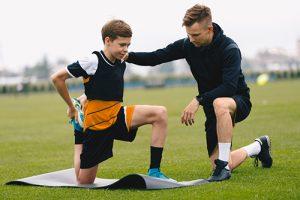 “Flexibility is particularly important for athletes who are in a rapid phase of growth,” says LaBotz. “As a young person grows, their bones grow first, and then the muscles and the tendons all stretch out to accommodate them before catching up. While they’re doing so, the athlete’s flexibility goes down, since there’s naturally more tension on the muscles and tendons.” So, if an athlete suddenly seems less flexible and has recently grown an inch or two, that’s not a cause for alarm. LaBotz explains, “Sometimes just maintaining flexibility requires dedicated effort during these growth phases.”
“Flexibility is particularly important for athletes who are in a rapid phase of growth,” says LaBotz. “As a young person grows, their bones grow first, and then the muscles and the tendons all stretch out to accommodate them before catching up. While they’re doing so, the athlete’s flexibility goes down, since there’s naturally more tension on the muscles and tendons.” So, if an athlete suddenly seems less flexible and has recently grown an inch or two, that’s not a cause for alarm. LaBotz explains, “Sometimes just maintaining flexibility requires dedicated effort during these growth phases.”
Understand what a ‘good stretch’ feels like
Stretching should never be painful, says LaBotz. Part of the reason stretching got a bad name was because athletes would sometimes be forced into stretches that were too intense. (You may be able to recall a physical education teacher pressing down on your upper back to ‘help you’ go further in a seated forward fold, taking the stretch from pleasant to painful.) “A good stretch feels like a bit of a pull, maybe a small amount of discomfort, but there should never be pain,” says LaBotz. Always err on the side of caution!
Find modalities that work for your athlete
LaBotz is a fan of combining different modes of stretching and improving flexibility and mobility, including static stretches, dynamic movements, equipment like foam rollers, and assisted methods like dynamic nerve glides, where the athletic trainer helps the athlete move through a range of motion that helps open up tight spots.
Incorporate static stretches at the right time
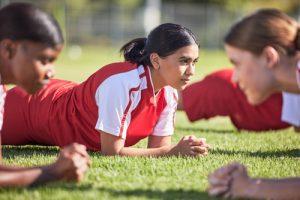 “Stretching is always best when the body is warm,” says LaBotz. “It’s great to do stretching as a cool down after practice—or if you want to do a stretch session before practice, still start with a warm up to get the blood flowing.” And when it comes to adding static stretches, especially around practice, aim for two holds of around 20 seconds each. “You don’t want to overdo it,” says LaBotz. “Too much of a good thing is not a good thing.” For rapidly growing kids, having some kind of stretching protocol most days of the week is ideal.
“Stretching is always best when the body is warm,” says LaBotz. “It’s great to do stretching as a cool down after practice—or if you want to do a stretch session before practice, still start with a warm up to get the blood flowing.” And when it comes to adding static stretches, especially around practice, aim for two holds of around 20 seconds each. “You don’t want to overdo it,” says LaBotz. “Too much of a good thing is not a good thing.” For rapidly growing kids, having some kind of stretching protocol most days of the week is ideal.
Skip stretching for more flexible athletes
The caveat to stretching for young athletes is that for naturally flexible kids, stretching isn’t the best use of their time. If an athlete is extremely flexible or even struggles with hypermobility, LaBotz notes that they need to spend that time working on stability and strength.
Check posture and mobility
“There are a couple of patterns that I’m noticing in young athletes now,” says LaBotz. “Many now have the ‘head forward’ position, often from being on phones or computers for most of the day. It sets these kids up for increased risk of back pain, as well as shoulder injury because it puts the shoulder in a bad position. Make sure that they’re doing some stretches across the front of their chests to open up that area.”
Individualize recommendations to your athlete’s specific sport
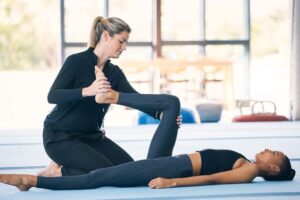 After assessing general posture, mobility, and flexibility concerns for an athlete, consider the sport-specific stretches that would be performance-enhancing. LaBotz reports, “A thrower, for instance, should focus on stretching out the posterior capsule in their shoulder, but for a swimmer, you would do the opposite and stretch out the anterior.”
After assessing general posture, mobility, and flexibility concerns for an athlete, consider the sport-specific stretches that would be performance-enhancing. LaBotz reports, “A thrower, for instance, should focus on stretching out the posterior capsule in their shoulder, but for a swimmer, you would do the opposite and stretch out the anterior.”
She also encourages athletic trainers to think beyond the basics and consider less-common stretches, such as hip stretches for a thrower since lower body rotation is important. “Pay attention to the whole kinetic chain,” she says. “Every athlete is going to come in with a different set of strengths and limitations, meaning they need to build up certain aspects to improve performance in their specific sport.”
Takeaway
Based on the latest research, athletic trainers can feel comfortable recommending both static and dynamic stretching after analyzing what will best serve an athlete based on their sport, body type, existing flexibility, and injury history.
What is TrueSport?
The TrueSport Champion Network is a community of coaches, parents, program directors, and athletes who believe in the power of youth sport to build life skills and core values for success both on and off the field. Join TrueSport Champion Network to help promote the positive values of cheer, dance, and STUNT!
The TrueSport Coaching Education Program empowers coaches—the most significant influencers in young athletes’ lives—with a transformative learning opportunity to obtain the knowledge and resources to cultivate, champion, and uphold the rich promise and highest potential of sport.
Additional Training Modules from TrueSport
USA Cheer is proud to partner with USADA’s TrueSport® to bring relevant educational content to the Cheer and STUNT community in order to promote a positive youth sport experience. We are excited to provide access to TrueSport’s experts that take coaching beyond skills and help truly develop the overall athlete by building life skills and core values for success on and off the mat, sideline, field, and court.
Feel free to share these resources with your coaching staff, parents, or athletes!
About TrueSport
TrueSport®, a movement powered by the experience and values of the U.S. Anti-Doping Agency, champions the positive values and life lessons learned through youth sport. TrueSport inspires athletes, coaches, parents, and administrators to change the culture of youth sport through active engagement and thoughtful curriculum based on cornerstone lessons of sportsmanship, character-building, and clean and healthy performance, while also creating leaders across communities through sport.
For more expert-driven articles and materials, visit TrueSport’s comprehensive library of resources.
This content was reproduced in partnership with TrueSport. Any content copied or reproduced without TrueSport and the U.S. Anti-Doping Agency’s express written permission would be in violation of our copyright, and subject to legal recourse. To learn more or request permission to reproduce content, click here.


